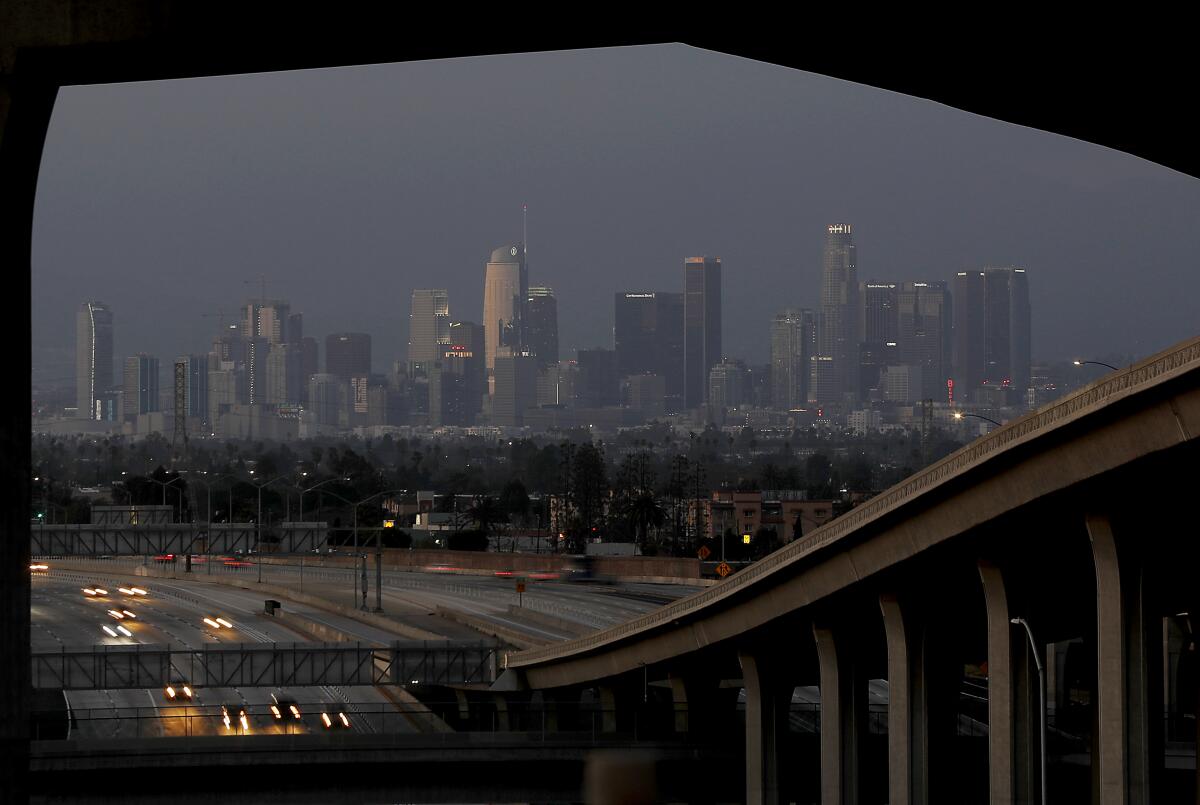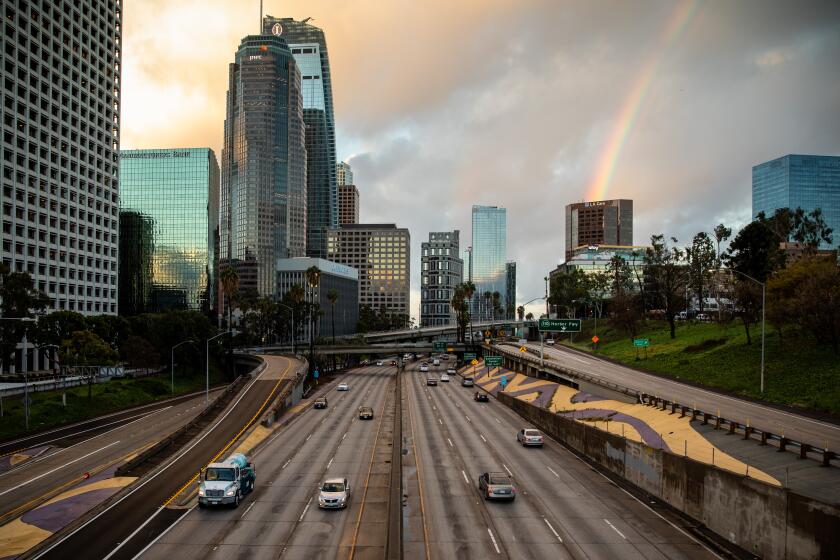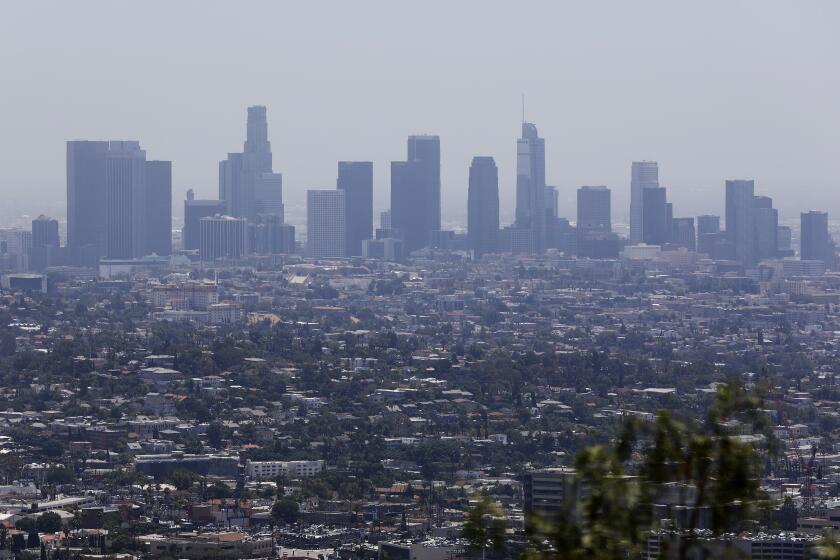How the coronavirus is hampering enforcement of California’s air pollution rules

The coronavirus is having another unintended effect on California’s environment, hindering the enforcement of clean-air rules that could help protect people’s lungs during the pandemic.
Field inspections have been halted since mid-March at the California Air Resources Board, which enforces rules on trucks, ships and other major pollution sources, because of health concerns about in-person investigations.
“All of our enforcement people are now working on analyzing data that we already have ... and they can do that work from their desks,” Air Resources Board Chair Mary Nichols said. “They are finding and initiating enforcement activities, but they are not out in the field driving around.”
Still, the hiatus means that an array of pollution sources, from soot-belching diesel trucks and cargo ships to methane-leaking landfills and oil and gas sites are undergoing far less scrutiny, at least on the ground, than is typical.
On-site inspections have also decreased at the South Coast Air Quality Management District, which regulates pollution from stationary facilities such as factories and oil refineries across Los Angeles, Orange, Riverside and San Bernardino counties.
That shift could be most consequential in the state’s smoggiest areas, including communities near ports, warehouses and freight corridors that remain hard-hit by health-damaging pollution. Air quality improved temporarily during the pandemic, in part because of spring weather. But smog has already returned to Southern California, with a string of recent bad air days in spite of dramatic reductions in vehicle traffic emissions under stay-at-home orders.
The prospect of reduced oversight of polluters worries environmentalists, especially at a time when people’s lungs are at risk from the novel coronavirus and need good air quality more than ever.
Coronavirus: L.A. clean air miracle has already come to an end. Here’s why
“Field inspections are often the best way to ensure that the rules are being followed, and everyone breathing the air in California deserves to know that our lungs and health are being protected,” said Bill Magavern, policy director for the Coalition for Clean Air. “For example, trucks that violate emissions standards expose nearby communities to excessive levels of toxic diesel exhaust, and roadside inspections are the best way to enforce the safeguards.”
In 2019, the state Air Resources Board averaged more than 2,800 inspections a month on trucks, ships, small off-road engines, consumer products and an array of other emissions sources, air board records show. Figures for this year were not available.
After switching to telecommuting on March 17, “we temporarily curtailed physical inspections, in order to meet social distancing requirements, and instead focused on desk audits,” Air Resources Board spokesman Dave Clegern said.
Clegern said the agency’s enforcement program “is open and active. Most of our programs do not rely on physical inspections as the sole means of identifying noncompliance.” Staff members continue to issue citations, close cases and and are able to continue enforcement on a wide range of programs “without conducting physical inspections in the field,” he said.
Toward a more sustainable California
Get Boiling Point, our newsletter exploring climate change, energy and the environment, and become part of the conversation — and the solution.
You may occasionally receive promotional content from the Los Angeles Times.
The Air Resources Board is updating its protocols and working to procure supplies such as masks, hand sanitizer, disinfecting wipes, and gloves, and expects to increase in-person inspections within the next month, focusing on the investigation of complaints at facilities such as landfills “where inspections are critical to ongoing enforcement,” Clegern said.
Southern California air quality officials said they are still conducting field inspections, though less frequently, and with precautions taken to protect employees and the public.
On-site inspections in March declined by about 15% to 20% compared with a year ago, as did complaints from the public about air pollution, according to estimates released by the South Coast air district.
At the same time, the district said it has ramped up surveillance operations, in which inspectors monitor facilities such as oil refineries, power plants and factories from a distance, using remote sensors and other methods to search for excess emissions without coming into close contact with people inside.
The California Environmental Protection Agency said some of its other boards and departments have also cut field inspections because of coronavirus restrictions. The Department of Toxic Substances Control has temporarily halted in-person inspections of hazardous waste facilities. The Department of Pesticide Regulation is still inspecting produce, but not physical stores or manufacturing facilities.
The decline in air inspection visits comes as both state and local environmental regulators in California have announced they will consider requests for temporary relief from compliance obligations that companies are having difficulty meeting because of coronavirus restrictions. Officials have been clear, however, that any leniency they will offer on compliance is far narrower than the U.S. Environmental Protection Agency suspension announced in March, which indefinitely waives a broad array of health and environmental protections in response to the pandemic.
An April 15 statement from the state EPA said that “remedies, such as the extension of deadlines, may be warranted,” but that regulated parties must submit “time-limited and specific requests that define the hardship” before falling out of compliance.
In addition to continuing investigations and taking action on complaints, the agency said it “will also fill any enforcement gaps left by the U.S. EPA’s decision to reduce environmental oversight.”
“Controlling pollution in communities with high rates of respiratory disease and multiple environmental burdens remains a priority,” the statement said, “especially given recent studies that suggest a correlation between these factors and COVID-19 susceptibility.”
Research by Harvard University scientists in April found substantially higher death rates from COVID-19 in U.S. counties where residents have been exposed to higher smog levels over years. Health experts suspect that bad air makes people more susceptible to the coronavirus, based on past findings about similar viruses.
The South Coast air district has also issued an “enforcement discretion” advisory offering temporary relief from some requirements.
“You can’t just go out and increase your pollution. You’ve got to abide by those emissions requirements,” South Coast air district Executive Officer Wayne Nastri said. “But if there’s a deadline for a report or if there’s something that you need to submit that’s administrative in nature, we’re going to give you time.”
Health and environmental groups say the study is stark evidence of the danger of weakening pollution safeguards during the coronavirus pandemic.
Nastri said air district staff made the changes after hearing an increasing number of informal requests, ranging from small, mom-and-pop businesses to sprawling oil refineries, that were having trouble meeting their regulatory obligations because of telecommuting, workforce reductions and social distancing requirements.
Bill La Marr, executive director of the California Small Business Alliance, applauded the air district as being responsive to the concerns of businesses that are either struggling or have been forced to shut down, and may be operating with expired permits or other violations.
“They’re going to be a little more open-minded than they normally would,” he said, which will be helpful to operations facing a slew of new requirements because of social distancing and other health constraints, La Marr said. “It’s going to be a real heavy lift, and some things may just be inadvertently overlooked.”
When it comes to inspections, La Marr said he doesn’t think anybody is using the coronavirus as an opportunity to skirt emission rules.
“They don’t go out deliberately to do this,” he said. “They’re interested in making money, and wasting product just through nefarious operations really isn’t economically viable.”
The South Coast district, meanwhile, has moved to stop scheduled fee increases on polluters in response to the pandemic, an action that will result in the loss of an estimated $2.5 million in revenue. That money could be used for agency operations such as hiring inspectors. It would also help reduce a massive, long-standing shortfall between what the district spends regulating emissions and what it recoups through fees.
Adrian Martinez, an attorney at the environmental law nonprofit Earthjustice, said the air district’s actions show it is bending too easily to industry complaints.
“Polluting industries have over the last couple decades built up a significant lobbying presence at AQMD to make it really painful and hard to adopt regulations, to increase fees for the agency to do its job and to develop a real air cleanup plan,” Martinez said, “and this is when that effort really shines.”










